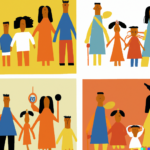Shifting concepts of family structures in today’s society reflect changing values and diverse lifestyles. Traditional notions of a nuclear family are giving way to a broader understanding of what constitutes a family unit. This shift is fueled by factors such as divorce rates, remarriages, and the rise of single-parent households. Additionally, the acceptance and recognition of same-sex marriages and non-traditional partnerships contribute to this evolving landscape. These changes raise important questions about the definition of family and challenge societal norms. The evolving family structures emphasize the importance of love, support, and acceptance, regardless of biological relationships. Families now come in different configurations, breaking traditional molds and fostering inclusivity and understanding.
Table of Contents
- Blended families
- Co-parenting arrangements
- Same-sex families
- Single-parent households
- Traditional family structures
(How Family Structure Drives Ideology)
Shifting concepts of family structures reflect the changing dynamics of modern society. Traditional ideas of family, centered around a married couple and their children, are no longer the only norm. Today, families come in various shapes and sizes, embracing diversity and inclusivity.
One notable change is the rise of single-parent households. Whether through divorce, death, or choice, many parents are raising their children alone. These families demonstrate strength, resilience, and a deep bond between parent and child.
Additionally, same-sex couples are gaining legal recognition and acceptance. These couples may choose to adopt children or have them through assisted reproductive technologies, creating loving homes filled with joy and laughter.
Another trend is the growing number of blended families. As individuals remarry or form new relationships, step-parents and step-siblings bring new connections and dynamics to the family unit. It can be challenging at times, but with open communication and mutual respect, these families can thrive.
Furthermore, non-traditional families, such as co-parenting arrangements or chosen families, have emerged. Some individuals may choose to raise children together without a romantic relationship, highlighting the importance of community and shared responsibilities.
The evolving notion of family also extends to the recognition of chosen families. These are close-knit groups of friends or individuals who support and care for each other as if they were blood relatives. They provide a sense of belonging, love, and support, challenging the idea that family is solely based on biology.
As society continues to change, our understanding of family structures must adapt. The beauty lies in the diversity and resilience of these families, showcasing the capacity of love to flourish in countless ways. Together, we can embrace and celebrate these shifting concepts, fostering a more inclusive and compassionate society.
Blended families
Blended families, a product of shifting concepts of family structures, are becoming increasingly common in today’s society. These families result from a remarriage or re-partnership, where one or both partners bring children from previous relationships into the new union.
Blended families offer a unique and complex dynamic, as they bring together individuals with diverse backgrounds, experiences, and expectations. This intricate blend often requires patience, understanding, and open communication to navigate successfully.
In a blended family, children may experience a range of emotions, including happiness, confusion, or even resentment, towards their new family arrangement. It is crucial for parents to create a safe and supportive environment, where children feel heard and valued. This helps foster a sense of belonging and eases the transition into the new family unit.
One of the many challenges faced by blended families is the need to establish new roles and boundaries. Parents must carefully balance the needs of their biological children with those of their stepchildren. This delicate balance ensures that all family members feel supported and included, while also having their individual identities respected.
Open and honest communication plays a vital role in the success of blended families. It is essential for all family members to express their feelings, concerns, and desires in a non-judgmental and respectful manner. This creates an atmosphere of trust and understanding, allowing everyone to work through any challenges that may arise.
Blended families also offer unique opportunities for personal growth and development. Stepparents, for example, have the chance to build close and meaningful relationships with their stepchildren, often becoming significant figures in their lives. Similarly, children in blended families have the opportunity to form new bonds and learn valuable life lessons about acceptance, resilience, and adaptation.
While blended families may face their fair share of challenges, they also have the potential to thrive and create loving, supportive, and harmonious environments. With patience, understanding, and a willingness to embrace the complexities that come with blending families, these unions can offer a rich and rewarding experience for all involved.
In conclusion, as our concept of family structures continues to shift, blended families have become a significant and increasingly common part of modern society. By fostering open communication, establishing clear roles and boundaries, and embracing the unique opportunities for growth, blended families can navigate the complexities of their union and create a loving and supportive environment for all members involved.
Co-parenting arrangements
Co-parenting arrangements are becoming increasingly common in today’s shifting concepts of family structures. More and more parents are embracing this alternative approach to raising children after separation or divorce.
Co-parenting involves both parents actively participating in the upbringing and care of their children, regardless of their romantic relationship status. This arrangement promotes shared responsibilities and ensures that both parents maintain a strong and consistent presence in their children’s lives.
One of the key benefits of co-parenting is that it provides a sense of stability and security for the children. They can rely on the love and support of both parents, even if they no longer live together. This fosters a healthy emotional and psychological environment for the children to grow and thrive.
Co-parenting also encourages effective communication and cooperation between parents. They must work together to make important decisions regarding their children’s education, healthcare, and overall well-being. This approach helps to minimize conflicts and ensures that the children’s best interests are always prioritized.
In addition, co-parenting allows for flexible parenting schedules that accommodate the needs and schedules of both parents. This ensures that the children have quality time with both parents and maintain strong bonds with each of them.
Furthermore, co-parenting teaches children valuable life skills, such as adaptability and resilience. They learn to navigate different households, rules, and routines, which can ultimately strengthen their problem-solving abilities and emotional intelligence.
While co-parenting can be challenging at times, especially when communication breaks down or conflicts arise, it is crucial for parents to prioritize their children’s well-being and work together to find common ground. This may involve seeking the help of mediators or therapists to facilitate productive discussions and resolutions.
In conclusion, co-parenting arrangements offer numerous benefits for both children and parents. They provide stability, promote effective communication, and teach valuable life skills. As our society continues to evolve, it is important to embrace these alternative family structures and empower parents to create nurturing and supportive environments for their children, even after separation or divorce.
Same-sex families
Same-sex families are a growing phenomenon, representing a significant shift in society’s understanding of family structures. These families, composed of same-sex couples raising children, challenge traditional notions of what a family should look like.
Same-sex families often face unique challenges due to societal biases and stereotypes. However, they demonstrate resilience and strength in navigating these obstacles. Their love and commitment to their children are just as powerful as in any other family.
Despite progress in acceptance and legal rights for same-sex families, there are still many obstacles they must overcome. Discrimination, prejudice, and unequal treatment persist in various aspects of their lives, including healthcare, education, and legal recognition.
Nevertheless, same-sex families continue to thrive, creating loving and nurturing environments for their children. The well-being of these children is not determined by the gender of their parents but rather the quality of the love and support they receive.
Research consistently shows that children raised in same-sex families fare just as well as their counterparts in opposite-sex families. They have been found to have similar levels of emotional well-being, academic achievement, and social development.
One of the unique aspects of same-sex families is the diversity within them. These families may include biological children, adopted children, or children from previous relationships. They also often have close networks of friends and extended family who play significant roles in their children’s lives.
Same-sex families demonstrate that family bonds are not solely defined by blood ties. Love, support, and commitment are the foundations of these families, regardless of their composition.
As society continues to evolve, it is essential to recognize and celebrate the contributions and experiences of same-sex families. By embracing diversity and equality, we can create a more inclusive society that benefits everyone.
In conclusion, same-sex families challenge traditional notions of family structures and demonstrate that love knows no boundaries. Despite the obstacles they face, they create nurturing environments for their children and contribute to the fabric of our society. By embracing and supporting same-sex families, we can pave the way for a more inclusive and just future.
Single-parent households
Single-parent households have become increasingly common in today’s society, reflecting the shifting concepts of family structures. With divorce rates on the rise and a growing number of people choosing to have children without being in a committed relationship, the traditional image of a nuclear family has evolved.
One of the most significant factors contributing to the increase in single-parent households is the changing dynamics of marriages and relationships. Many couples find themselves unable to sustain their unions, resulting in separation or divorce. This leaves one parent to raise the children on their own. While it can be a challenging and emotionally taxing responsibility, single parents often rise to the occasion, providing love, care, and stability for their children.
Furthermore, the notion that a child needs both a mother and a father has become less prevalent. Society has come to recognize that what truly matters is a supportive and nurturing environment, regardless of the gender of the parent. Single parents work hard to create such an environment for their children, offering a sense of security and love that is crucial for their overall development.
Another significant trend within single-parent households is the increase in the number of people choosing to have children without being in a committed relationship. Whether through choice or circumstance, individuals are embracing parenthood, realizing that they are fully capable of raising a child on their own. This decision reflects the changing attitudes towards family structures, prioritizing the well-being of the child above societal expectations.
It is important to acknowledge that single-parent households face unique challenges. The responsibilities and pressures of being the sole provider and caregiver can be overwhelming at times. However, single parents often possess an unwavering determination to ensure their children’s happiness and success, allowing them to overcome obstacles with resilience.
In conclusion, single-parent households have become more prevalent as traditional family structures evolve. Whether through divorce or personal choice, single parents are taking on the task of raising children on their own. Recognizing the importance of a supportive and nurturing environment, society has come to understand that children thrive in a loving and stable household, regardless of the gender of the parent. While it may present challenges, single parents demonstrate immense strength and resilience in providing for their children’s well-being. The shifting concepts of family structures highlight the diverse and dynamic nature of modern families.
Traditional family structures
Traditional family structures have long been the societal norm, serving as the foundation of communities and shaping the upbringing of generations. However, in recent times, there has been a shift in the concept of family structures, challenging the traditional ideals.
In the past, the traditional family structure commonly consisted of a heterosexual couple legally married, living together, and raising their biological children. This model was seen as the ideal and was deeply ingrained in cultural and religious values. It provided a sense of stability and security.
Today, however, the definition of family structure has broadened to accommodate various forms. Single-parent households, same-sex couples raising children, and extended families residing together have become increasingly prevalent. These non-traditional family structures reflect the evolving values and societal acceptance of diverse family dynamics.
This shift in family structures has stemmed from various factors. Changing attitudes towards gender roles, advancements in reproductive technologies, and increased acceptance of LGBTQ+ rights have all contributed to this evolution. As a result, the traditional family structure is no longer the sole blueprint for a fulfilling family life.
While some may argue that this shift has detrimental effects on society, it is important to embrace the diversity in family structures. Non-traditional families can provide just as much love, support, and stability as traditional ones. What matters most is the presence of a nurturing environment where individuals feel loved and valued.
Children raised in non-traditional family structures have been found to develop resilience, empathy, and open-mindedness, as they are exposed to different perspectives from an early age. It is vital to recognize that love and care, not the structure itself, should be the defining factors in determining the success of a family unit.
Society’s understanding of family structures needs to adapt to the changing times. By dismantling rigid notions of what a family should be, individuals can define their own unique paths to happiness and fulfillment. This inclusivity paves the way for a more compassionate and accepting world.
In conclusion, the traditional family structure no longer holds an exclusive position in defining family life. The concept of family has expanded to incorporate diverse forms, reflecting the changing attitudes and values of society. Non-traditional family structures offer opportunities for growth, understanding, and love. It is time to embrace this shift and celebrate the myriad of paths that lead to a fulfilling family life.









